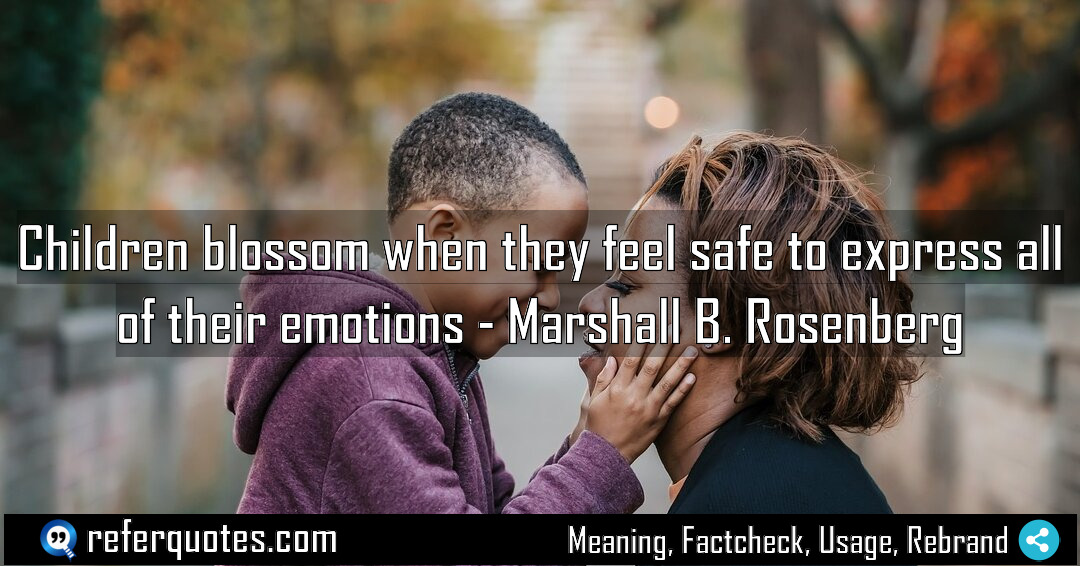
Children blossom when they feel safe… it’s a simple but profound truth. This quote gets to the heart of what real emotional development looks like. It’s not about constant happiness, but about creating a foundation of security.
Share Image Quote:
Table of Contents
Meaning
At its core, this is about psychological safety. It means that a child’s full emotional, social, and cognitive potential unfolds naturally when they don’t have to hide any part of their inner world.
Explanation
You see, we often think of “blossoming” as a child being happy and successful. But Rosenberg flips that. He’s saying the blossoming is the result of the safety. When a kid knows they can come to you with their anger, their fear, their big, messy disappointment and be met with understanding instead of punishment or dismissal… that’s the fertilizer. Their energy isn’t spent on suppressing emotions. It’s freed up for curiosity, for learning, for connection. It’s the difference between a plant thriving in rich soil versus one just surviving in concrete. The concrete one might look okay, but it’s never going to reach its full, vibrant potential.
Quote Summary
Reading Level68
Aesthetic Score86
Origin & Factcheck
This comes straight from Marshall B. Rosenberg’s 2005 book, Raising Children Compassionately: Parenting the Nonviolent Communication Way. It’s a core tenet of his NVC methodology. You sometimes see similar sentiments floating around, but this specific, beautiful phrasing is Rosenberg’s.
Attribution Summary
Where is this quotation located?
| Quotation | Children blossom when they feel safe to express all of their emotions |
| Book Details | Publication Year/Date: 2004; ISBN/Unique Identifier: 9781892005140; Last edition: PuddleDancer Press, 1st Edition, 48 pages. |
| Where is it? | Chapter: Emotional Safety, Approximate page from 2005 edition |
Context
In the book, he’s directly challenging the common parenting trap of rewarding “good” emotions and punishing “bad” ones. The context is about moving away from a system of judgment and control, and toward one of empathetic connection. It’s the foundation for everything else in Nonviolent Communication for families.
Usage Examples
So how does this look in the real world? Let’s say your kid is having a meltdown because they lost a game.
- For a Parent: Instead of “Don’t be a sore loser,” you might say, “You’re really disappointed and angry right now, huh? It’s tough when you try hard and don’t win.” You’re naming the emotion, making it safe.
- For a Teacher: Creating a classroom where a student can say “I’m frustrated with this math problem” without shame. That’s the safety that allows for academic risk-taking.
- For a Coach: Acknowledging a player’s fear of failing in a big game, rather than just yelling “Be tough!” That safety to be vulnerable actually builds real resilience.
To whom it appeals?
Share This Quote Image & Motivate
Motivation Score82
Popularity Score78
Shareability Score80
FAQ
Question: Does “all their emotions” mean I have to let them be destructive or disrespectful?
Answer: Absolutely not. This is the biggest misconception. The feelingbehaviorexpress
Question: Isn’t this just permissive parenting?
Answer: It’s the exact opposite. Permissive parenting avoids the emotion. This is engaged parenting. You’re stepping into the emotional storm with them, setting firm, compassionate boundaries on behavior while validating the feeling underneath. It’s actually more work, but it builds a stronger, more authentic connection.
Question: What if I wasn’t raised this way? How do I start?
Answer: Start small. You don’t have to be perfect. Just try to notice one emotion your child expresses and simply name it without judgment. “You look really excited about that!” or “It seems like you’re feeling lonely right now.” That act of noticing and naming is the first, most powerful step to creating that safety.
Similar Quotes
You know, when Marshall Rosenberg said “Children flourish when they feel safe, seen, and heard,” he wasn’t just talking about parenting. He was giving us the master key to human…
Children learn who they are by how we respond. This simple idea from Marshall Rosenberg completely reframes parenting. It’s not about rewards or punishments, but about how we mirror their…
To nurture empathy in children, we must first give them space. It sounds simple, but this is the foundational secret. You can’t teach compassion if a child feels emotionally unsafe.…
You know, when Marshall Rosenberg said “Children thrive when they feel seen, heard, and understood,” he wasn’t just talking about parenting. It’s the absolute bedrock of human connection. I’ve seen…
Children mirror the emotional climate of their home. It’s a simple but profound truth I’ve seen play out time and again in my work. When you really get it, it…
